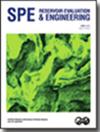低渗透水湿砂岩岩心低速率水驱采油研究
IF 1.5
4区 工程技术
Q3 ENERGY & FUELS
引用次数: 3
摘要
智能水或低矿化度(LS)注水是一种环保的高效油气开采方法。润湿性向更湿的水条件变化和水的自发吸胀(SI)增加是提高石油产量的原因。润湿性改变和从低渗透基质中驱油的SI是一个时变过程,注入速度和油粘度都是影响毛细力和粘滞力对石油生产贡献的重要因素。在实验室岩心驱油中,必须采用低驱油速率,以实现SI和改进的波及。在不同的驱油速率、润湿条件和初始含油饱和度下,通过水驱和SI测定了低渗透石灰岩和高渗透砂岩中的残余油饱和度。在本研究中,研究了驱油速率对低渗透、水湿的Bandera Brown露头砂岩岩心驱油的影响。除了SI实验和使用具有不同油粘度的矿物油外,还通过以两种不同的速率注入来改变粘滞力。结果表明,在高速率和低速率下,SI驱油和粘性驱油的采收率差异很小,这表明毛管力对这种低渗透、水湿岩石的石油动员和生产过程起着重要作用。通过改变油的粘度,结果表明毛细力对高油粘度下的驱油特别重要,因为低速率注入的最终采收率高于高速率注入的最终采收率。毛细管数计算表明,黏性力在采收率试验中占主导地位;然而,实验表明,毛细力对于本研究中使用的低渗透、水湿岩心的高效驱油非常重要。在高注入速率和低注入速率(包括SI)下产生的压降与最终采收率之间没有直接联系。因此,为了模拟储层中部的产油量,我们得出结论,在实验室测试中需要进行低速率水驱,以使SI进入基质,通过正毛细力取代油。在不同注入速率下使用不同粘度的油,可以为如何在低注入速率下提高水驱效率的文献提供一些额外的信息。本文章由计算机程序翻译,如有差异,请以英文原文为准。
Oil Recovery by Low-Rate Waterflooding in Low-Permeability Water-Wet Sandstone Cores
Smart water or low-salinity (LS) water injection are environmentally friendly methods for efficient hydrocarbon recovery. Wettability alteration toward more water-wet conditions and increased spontaneous imbibition (SI) of water are responsible for enhanced oil production. Wettability alteration and SI to expel oil from the low-permeability matrix are time-dependent processes and both injection rate and oil viscosity are important factors affecting the contribution of capillary and viscous forces to oil production.
Low flooding rate must be applied in laboratory corefloods to allow for SI and improved sweep to take place. Residual oil saturation by waterflooding and SI has previously been determined in low-permeability limestone and in higher permeability sands under various flooding rates, wetting conditions, and initial oil saturations. In this study, the effect of flooding rate on oil displacement from low-permeability, water-wet Bandera Brown outcrop sandstone cores has been examined. Viscous forces have been varied by injection at two different rates in addition to SI experiments and using mineral oils with different oil viscosities.
The results showed small differences in oil recovery by SI and viscous flooding at high and low rates, indicating that capillary forces contribute significantly to the oil mobilization and production process from this low-permeability, water-wet rock. By varying the oil viscosity, the results indicated that capillary forces were especially important for oil displacement at higher oil viscosity as the ultimate oil recovered by low-rate injection was higher than that from the high-rate injection. Capillary number calculations indicated that viscous forces should be dominant in the recovery tests; however, the experiments showed that capillary forces were important for efficient oil displacement from the low-permeability, water-wet cores used in this study. There was no direct link observed between generated pressure drops at high and low injection rates, including SI, and the ultimate oil recovery. Thus, to simulate oil production in the middle of the reservoir, it was concluded that low-rate waterflooding is needed in laboratory tests to allow SI into the matrix to displace oil by positive capillary forces.
The combination of using oils that differ in viscosity at different injection rates could add some additional information to the literature on how to increase the efficiency of waterflooding with a low injection rate.
求助全文
通过发布文献求助,成功后即可免费获取论文全文。
去求助
来源期刊
CiteScore
5.30
自引率
0.00%
发文量
68
审稿时长
12 months
期刊介绍:
Covers the application of a wide range of topics, including reservoir characterization, geology and geophysics, core analysis, well logging, well testing, reservoir management, enhanced oil recovery, fluid mechanics, performance prediction, reservoir simulation, digital energy, uncertainty/risk assessment, information management, resource and reserve evaluation, portfolio/asset management, project valuation, and petroleum economics.

 求助内容:
求助内容: 应助结果提醒方式:
应助结果提醒方式:


